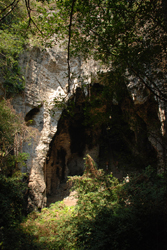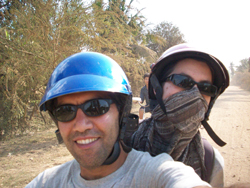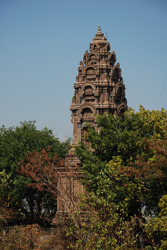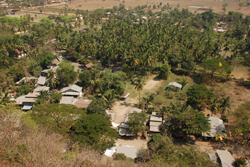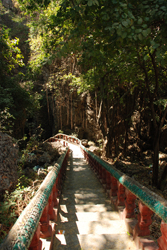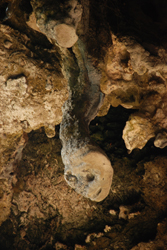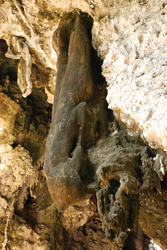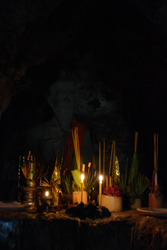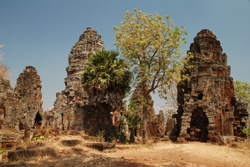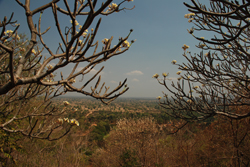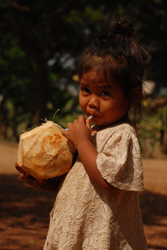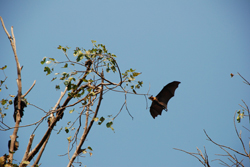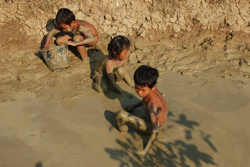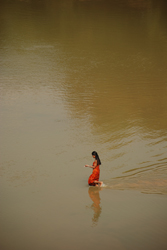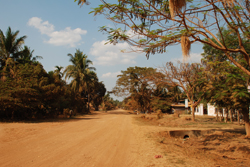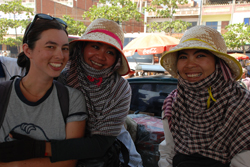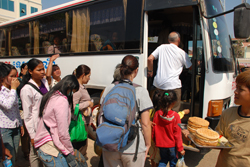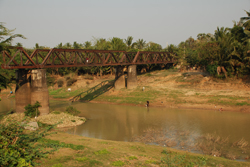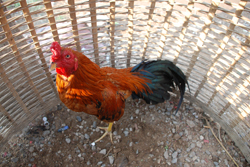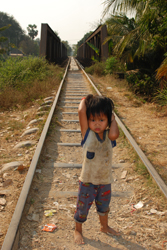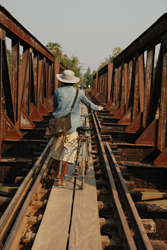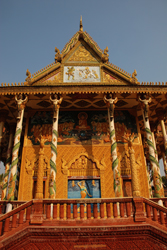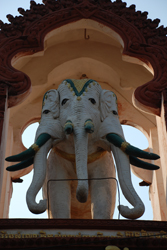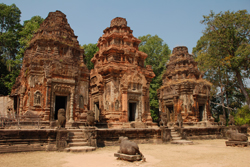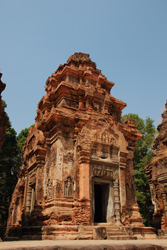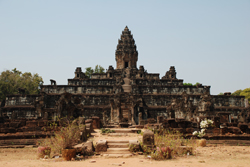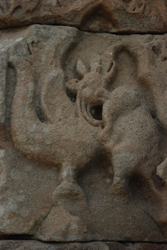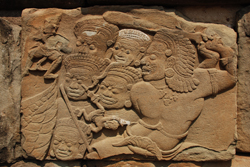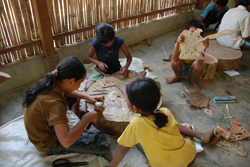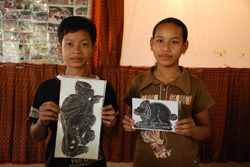Visiting the Battambang Countryside
10 February, 2009, 02:06 am in "Cambodia"
Battambang's proximity to the countryside is the main draw for the tourists who do make it to the town. Unlike Siem Reap, it is possible to rent a motor bike though people do hire tuk tuks and motor taxis.
As an excuse to get out into the countryside, we headed to the site of Phnom Sampeau, infamous for its “killing caves” which were used by the Khmer Rouge. The road started out paved but quickly became dirt which was stirred up into clouds of dust as cars went by. People on motorbikes wear face masks. The countryside is flat with fields, dry lakes with lotus flowers and lily pads looking strangely abandoned by water on stems a couple feet from the mud.
As an excuse to get out into the countryside, we headed to the site of Phnom Sampeau, infamous for its “killing caves” which were used by the Khmer Rouge. The road started out paved but quickly became dirt which was stirred up into clouds of dust as cars went by. People on motorbikes wear face masks. The countryside is flat with fields, dry lakes with lotus flowers and lily pads looking strangely abandoned by water on stems a couple feet from the mud.
We passed a couple duck farms. A group of ducks walked alongside the road in a long parade. Sometimes we'd pass a small village with wooden shop shacks lining the road. Our map wasn't too clear and at first we worried about missing the turn off to Phnom Sampeau. Then I rememebered, “Phnom means hill. Any hill is going to be pretty obvious since everything is so flat.” So far I'd seen about 2 hills in Cambodia. Sure enough, in the distance, a hill appeared through the haze with gold spikes of Wat Sampeau. The road soon became lined with restaurants and people selling stuff, a sure sign we were in the right place. At the foot of the hill, workers were in the process of carving a standing Buddha into the mountain.
We climbed the stairway up the mountain. The stairs branched off so we chose one set and ended up by a shrine. Then, taking a forest path, we ended back on the other set of stairs. At the top of the mountain was a wat and various shrines. Below the land stretched flat into the distance-- field, ponds, and patches of jungle alternating until they blended into the haze.
We climbed the stairway up the mountain. The stairs branched off so we chose one set and ended up by a shrine. Then, taking a forest path, we ended back on the other set of stairs. At the top of the mountain was a wat and various shrines. Below the land stretched flat into the distance-- field, ponds, and patches of jungle alternating until they blended into the haze.
From the back of the wat, I noticed a steep staircase going down a gap between tall limestone walls. We followed it down and the walls became a kind of open grotto-- a natural tunnel through the rocks. The light washed in through the greenness of the jungle and touched 2 statues on the floor of the grotto. Strange limestone formations hung from the ceiling. Two women pointed out to us that if we stood on one side one looked like a cobra and another, a person hanging upside down (or a dragon). On one side of the grotto was an indentation holding a statue of a child. There were a couple caves off to the sides. One held a Buddha statue in the back lit in the darkness by candles. It was a dark secretive cave filled with the smell of incense. Another smaller cave seemed to hold just a lot of mosquitoes. Outside butterflies fluttered like lost souls.
I believe these caves are known as the “killing caves” because the Khmer Rouge executed people and left the remains in the caves.
Next, we headed down the road to Phnom Banan. Wat Banan, located on the top of the hill, is the ruin of an 11th century Angkor temple. Locals say its 5 towers were the inspiration for Angkor Wat. The towers were fairly ruined but the central one still had intact carvings. Since it was on a hill it had a great view.
Next, we headed down the road to Phnom Banan. Wat Banan, located on the top of the hill, is the ruin of an 11th century Angkor temple. Locals say its 5 towers were the inspiration for Angkor Wat. The towers were fairly ruined but the central one still had intact carvings. Since it was on a hill it had a great view.
We walked back down and went to a restaurant for a drink. The woman had come up to us trying to sell drinks but unlike the drink pushers at Angkor she didn't annoy us. I suppose it is mutual. The farther we get from touristy areas the less pushy people become. This in turn makes us more friendly and polite. In touristy places it seems like everyone drives each other crazy.
We bought a pomegranate green tea drink and she served glasses with ice. The tourist policeman-- a boyish looking young man-- was swinging in a hammock. Two other men sat at a table. They started talking to us. The usual questions-- Where are you from? How long are you in Cambodia for? Etc. When Rowshan said he was from Iran, they expressed approval which surprised us because 1. Most people get Iran and Iraq mixed up and 2. Usually only Muslims are impressed by Rowshan being Iranian. These men clarified. The reason for their approval of Iran was their disapproval of what Israel was doing against the Palestinians. Rowshan asked the tourist policeman if other Iranians had come there and the policeman said, “You are the first.” One of the other men spoke English decently. He was older with a grin revealing most of his teeth were missing. He had traveled in China in the 60s. The policeman asked Rowshan if he knew how to play Cambodian chess. Rowshan responded he knew how to play regular chess but not whatever “Cambodian” chess was. The policeman and one of the other men sat down to play Cambodian chess. As far as I can tell, Cambodian chess is the same as regular chess except there might be a few pieces missing and shells had replaced most of the pawns. However the main difference is the way they play. Most of the time chess is silent and thoughtful. They played it more like backgammon-- quickly with much banter and baiting.
We left them to their game and headed back to town. We stopped by a wat with trees full of bats near it. The road continued past wooden stilt houses with Brahmin bulls wandering around and grazing in front, and people resting in hammocks underneath, avoiding the heat of the day. Above, clouds dotted the sky like thought bubbles of a distracted person.
We found some kids who were beating the heat in a different way. In a muddy water-filled irrigation ditch, a group of kids were fishing. They had dammed off an area of the water and then bailed out the water with a basket. The kids scrambled around in the mud catching fish by hand, coating themselves with mud in the process.
The road but seemed to be getting farther from the river instead of going along it as we thought it would. At an intersection we asked directions... simply, “Battambang?” 3 different people simultaneously pointed down the 3 different roads available. Fortunately a guy who knew English appeared and was able to direct us to the river. The river is muddy but that doesn't stop people from swimming, bathing and washing everything it. Houses that are more like open terraces line it with hammocks hanging under the thatched or corrugated metal roofs.
We tried to find the bamboo train stop (which wasn't where we thought it was the previous night). We turned off the main road and seemed to be going along a dirt road in a jungle with little wooden and thatch houses that reminded me of the village we visited near Pucalpa-- but this was only about 5 minutes from the center of a city. We ended up getting a bit lost and since we were tired and dusty, we headed back into town.
Battambang: Pleasantly Normal
9 February, 2009, 02:06 am in "Cambodia"
The bus stopped in Sisophon for a 20 minute lunch break. It was 10:30 AM so maybe it was a mid-morning snack break. Vendors must hate air-conditioned buses which make it harder to sell... no shoving last minute purchases through an open window as the bus pulls off.
Since we had time, we walked inside the bus station parking area and saw a woman selling fresh spring rolls. We tried two and then ate 2 more. Some of the locals laughed at us. I'm not sure if it was Rowshan's hair or how we were stuffing our faces.
There were a couple women waiting for a pick-up truck. Rowshan took their photos as they sat on the truck and they pulled me into the picture, pinching my cheeks as if I were a little kid even though they were either around the same age as us or younger. They were friendly and one spoke a little English. I said, “Akun” (thank you) and she said, “speak Khmer?”. “No,” I replied. “Just 'akun'” She then asked if Rowshan was my boyfriend. Rowshan said, “Husband (pointing at himself)” “wife” (pointing at me). She then repeated, “Speak Khmer!” and told us what we hope were the words for husband and wife in Khmer.
Since we had time, we walked inside the bus station parking area and saw a woman selling fresh spring rolls. We tried two and then ate 2 more. Some of the locals laughed at us. I'm not sure if it was Rowshan's hair or how we were stuffing our faces.
There were a couple women waiting for a pick-up truck. Rowshan took their photos as they sat on the truck and they pulled me into the picture, pinching my cheeks as if I were a little kid even though they were either around the same age as us or younger. They were friendly and one spoke a little English. I said, “Akun” (thank you) and she said, “speak Khmer?”. “No,” I replied. “Just 'akun'” She then asked if Rowshan was my boyfriend. Rowshan said, “Husband (pointing at himself)” “wife” (pointing at me). She then repeated, “Speak Khmer!” and told us what we hope were the words for husband and wife in Khmer.
We said “goodbye” and boarded the bus. I bemoaned the mandatory meal break because it gave parents a chance to re-fill the stomachs of their bus-sick children, the contents of which would invariably come back up within the next half hour of the bus ride. We had a child puke next to us and diagonal to us. A noise and smell from behind us suggested the kid sitting there had as well. The road, though a bit bumpy, was completely straight and flat. I'd hate to see how they'd fare on the road from Khorog to Dushanbe. Another pet puke peeve I have is when people throw up and keep their bag of puke instead of throwing it out at the first opportunity. On the road from Pokhara to Kathmandu we actually handed a guy (who was behind us) his bag of puke which he had left sitting on on his seat and told him to get rid of it. Instead of getting back off the bus and disposing it somewhere, he just dropped it out the window which probably unpleasantly surprised whoever stepped on it. Anyway, the parent across from us had hung her daughter's puke bag from the bottom of the seat where it contributed to the odor of the bus. I was, for once, relieved to have foreigners in the 4 seats in front of us so we weren't completely surrounded by puking people.
Battambang's appeal is it doesn't really have tourist sights so it is a normal town with a normal economy. Tourists are treated fairly normally-- a few offers of tuk tuks or moto-taxis at hotels but that's it. The river is pleasant enough to walk along but it's nothing special. The historical buildings are masked by dirt and big signs advertising the businesses housed within. There is a museum and some nice wats but nothing to compete with Angkor.
There is a central market with food vendors in the center selling noodles, soup and fried meat. They leave around 5 PM and are replaced by barbecue meat vendors with whole chickens and ducks turning on spits and little skewers with pieces of meat, red with sauce.
For lunch I had baboung--a yummy dish of cold rice noodles with a little broth on a bed of lettuce, mint, basil and bean-sprouts, fried pork pieces, a couple cut up spring rolls, coconut milk, and ground peanuts topping it off. It seems very simple but is very tasty.
Later we decided to sample some exotic fruit. We tried pieces of some big round citrus fruits which looked like grape fruit but tasted sweet, almost like pineapple. We were surprised when we were quoted $1 for one fruit. At the central market we tried something that might have been Ple Teuk Doh Kau (the word the seller gave us sounded something like tik-tak-toe), a round purple fruit with slimy insides and mien which are like lychees.
Our walk through town soon brought us to a village. Battambang is Cambodia's 2nd largest city but waling about ½ hour from the center brought us to villages with stilt houses and Brahmin bulls grazing in the fields.
For lunch I had baboung--a yummy dish of cold rice noodles with a little broth on a bed of lettuce, mint, basil and bean-sprouts, fried pork pieces, a couple cut up spring rolls, coconut milk, and ground peanuts topping it off. It seems very simple but is very tasty.
Later we decided to sample some exotic fruit. We tried pieces of some big round citrus fruits which looked like grape fruit but tasted sweet, almost like pineapple. We were surprised when we were quoted $1 for one fruit. At the central market we tried something that might have been Ple Teuk Doh Kau (the word the seller gave us sounded something like tik-tak-toe), a round purple fruit with slimy insides and mien which are like lychees.
Our walk through town soon brought us to a village. Battambang is Cambodia's 2nd largest city but waling about ½ hour from the center brought us to villages with stilt houses and Brahmin bulls grazing in the fields.
We were trying to find the bamboo train and made it to the tracks but didn't feel like waiting around for the train-- a bamboo platform powered by a motorcycle engine which runs on the train tracks. We crossed the railroad bridge which had boards nailed down the middle of the tracks making it walkable.--though a bit scary, with the murky river below. On the other side of the river was a wat. We visited it then headed back to the center.
Angkor: The Roluos group
8 February, 2009, 02:39 am in "Cambodia"
We finished up our Angkor pass with a trip to the Roluos group of temples about 13 km East of Siem Reap. We had been debating going. Rowshan's knee was hurting and we are getting a bit templed out. But, since he was feeling better, we decided we might as well. The bike ride was partially the same as our unsuccessful trip to Kampong Phluk-- the easy part fortunately.
The road was busy going by the market but eventually it was spacious. One stretch passed by workshops where people made sculpted pieces for temples and décor out of concrete. Coming back there were about 10 guys climbing and hammering at a Buddha sculpture.
The temples in the Roluos group are the oldest of the Angkor temples, built in the 9th century by Indravarman I. Preah Ko was a group of 6 towers. They were in ruins of course but some of the lintels and doorway columns were in decent condition.
The road was busy going by the market but eventually it was spacious. One stretch passed by workshops where people made sculpted pieces for temples and décor out of concrete. Coming back there were about 10 guys climbing and hammering at a Buddha sculpture.
The temples in the Roluos group are the oldest of the Angkor temples, built in the 9th century by Indravarman I. Preah Ko was a group of 6 towers. They were in ruins of course but some of the lintels and doorway columns were in decent condition.
The Bakong was a large temple mountain with a pretty moat and cared-for grounds with flowers and trees. There was a wat inside the grounds so they probably served a more active duty than the other ruins. The top had just one large tower where we found a carving of a chicken with an elephant hanging from its beak-- more evidence of the Giant Chicken.
On the way back up the road we stopped at a workshop across from Preah Ko where children were making designs and traditional shadow puppets by punching and cutting leather. The children were orphans or just poor and some of the money went directly to them and the other part went to the orphanage for their food and care. Although it is sad they have to work, it seemed like a good job. They were learning traditional arts/handcrafts and they seemed happy enough. They sat on the ground with wooden stumps for work tables. Rowshan and I chose a monkey and a rabbit. The sales kid called a boy and a girl over. The boy had made the monkey and the girl had made the rabbit. We thanked them and they thanked us. Then we biked back to town.
Powered by My Blog 1.69. Copyright 2003-2006 FuzzyMonkey.net.
Created by the scripting wizards at FuzzyMonkey.net..
(Code modified by Rowshan Dowlatabadi)
Created by the scripting wizards at FuzzyMonkey.net..
(Code modified by Rowshan Dowlatabadi)


